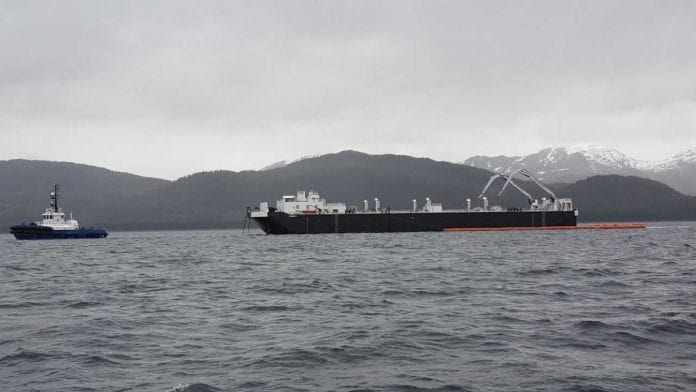
By W. Scott Pegau
For The Cordova Times
At the beginning of May, a few boats from Cordova got the opportunity to begin working with the new oil spill response barge and tugs being brought to Prince William Sound by Edison Chouest Offshore. The tug, Elrington, brought the barge, OSRB-1, to Sheep Bay to conduct a drill with two of the rapid response vessels of opportunity and two of the core fleet vessels.
The OSRB-1 represents the next generation in spill response capability for Prince William Sound. It is one of four barges designed for offshore spill response that will be working in the area beginning this summer. The new barges are designed to deploy large current buster boom systems off either side without the assistance of other vessels. Smaller vessels can then pull alongside and pick up the outside leg of the buster and tow with the tug and barge. Once the buster systems are in operation, cranes on either side of the barge lower the new Crucial skimmer packages into the boom for oil collection. Both the buster and skimmer are designed to greatly reduce the amount of water collected when skimming oil.

During the drill, the Cordova-based bowpickers Delta Tango and Boswell Bay were the first vessels to pick up the buster system legs and begin towing.
For the most part, the towing speed was kept fairly slow at about one-and-a-half knots but was taken up to three knots for a short time to see if it was within the capabilities of the bowpickers to tow the system with the tug.
For such a large boom system, it did not seem that difficult to tow at even three knots. The boats were also asked to make a few turns with the system to work on the communications necessary to have four vessels maneuver together.
Once the ability of the bowpickers was determined, they cast off their leg of the boom system and seiners Shadow Dawn and Double Trouble picked up the boom and continued the exercise.
Many have been waiting to see how the transition from the oil spill response barges operated by Crowley to those operated by Edison Chouest Offshore would go. Based on this drill, it is clear the new barges represent the next evolution in oil spill response capabilities for Prince William Sound.
While we hope never to see the new technology actually being used, it is nice to see that there is an investment to ensure the best systems are available.
Thanks to the many years of service of Crowley with its tugs and barges, and welcome to the new crews and systems being brought by Edison Chouest.
Scott Pegau is the research program manager for the Oil Spill Recovery Institute in Cordova.
The opinion expressed here is that of the author only, and not that of The Cordova Times.














